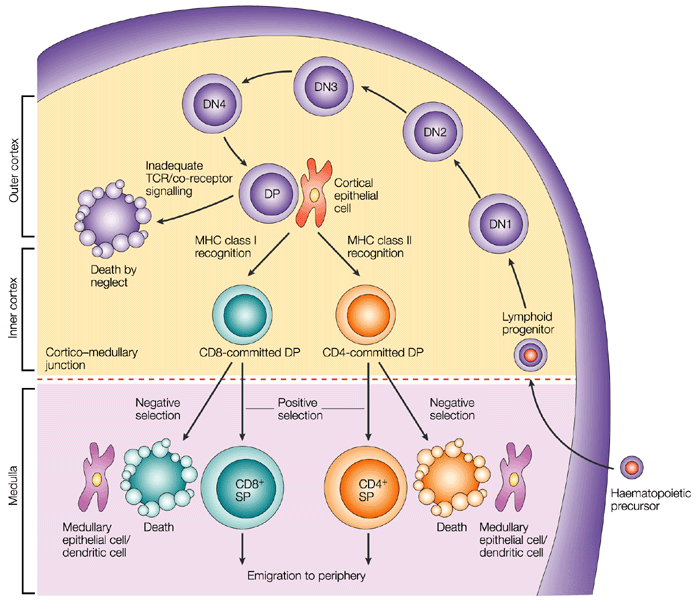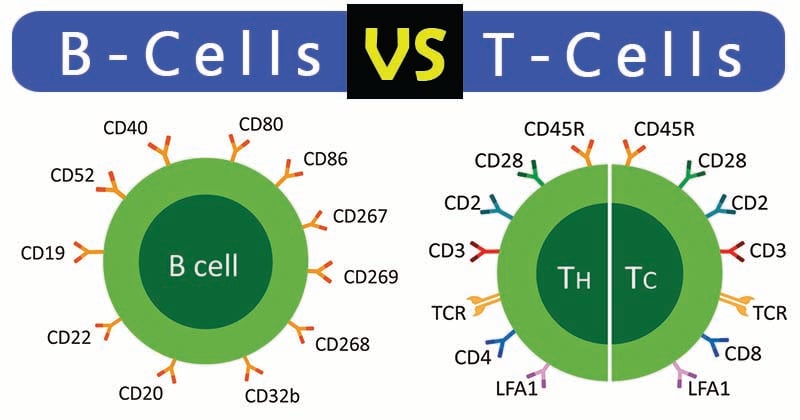Which Best Distinguishes B Cells From T Cells
Difference Between T cells and B cells The immune system is formed by a complex network of cells organs and processes interacting together to constitute the main defense line of the human body against foreign organisms and diseases. B lymphocytes both originate and mature in the bone marrow.

T Cell Markers And B Cell Markers
B cells mature in the bone marrow while the T cells travel to the thymus and mature there.

. T-cells can only connect to virus antigens on the outside of infected cells. Lymphocytes are further subdivided into T lymphocytes B lymphocytes and NK cells. Also subcapsular and medullary cords of lymph nodes.
T cells and B cells differ in their functions like T cells are known to develop various immune response such as invading bacteria from bodys immune system virus attacks not supporting the organ transplant etc while B cells produce antibodies against the antigen. Plant cells have large vacuoles and animal cells do not. Mature B cells occur mostly outside the lymph node.
Despite showing variance in their working T and B cells struggle with the same aim of. Both the cells are. A new fluorescent probe that can distinguish B cells from T cells.
B B cells kill viruses directly. Distinguishing and separating different types of these cells is highly important in carrying out studies in the. Which of the following best distinguishes Treg cells from other CD4 T cells.
By Institute for Basic Science. A B cells confer active immunity. Plant cells have more lysosomes than animal cells have.
The cells are nucleated and motile. The main two types of cells in blood are red blood cells RBC and white blood cells WBC. BPlant cells have more lysosomes than animal cells have.
Which statement best describes the difference in responses of effector B cells plasma cells and cytotoxic T cells. The key difference between T lymphocytes and B lymphocytes is that the T lymphocytes originate in bone marrows and mature in the thymus while B lymphocytes originate and mature in bone marrows. One of its main components are lymphocytes a subtype of white blood cells which include two types of cells.
They are a type of lymphocytes. Surface antigen of invading pathogen are taken up by B cells 2. D effector B cells secrete their receptors but effector T cells do not.
B cells and T cells are the white blood cells of the system that are liable for adaptive immune reaction in an organism. But the adaptive immune system is slow and can take several days before two key cell types B cells and T cells are brought into play. Self-MHC class II and a TCR both bound to a non-TCR-specific peptide Self-MHC class II and a TCR both bound to a TCR.
Thus humoral immunity depends on. Eukaryotic cells contain a nucleus whereas prokaryotes do not and eukaryotes show greater. B cells are activated to divide by mitosis and give a clone of plasma cells 5.
Prokaryotic cells are much larger than eukaryotic cells. Which of the following best distinguishes a prokaryotic cell from a eukaryotic cell. Similarities between B cells and T cells Both B and T cells originate in the bone marrow.
Cytotoxic T cells confer passive immunity. Cytotoxic T cells kill virus-infected cells. Both the cells are made in the bone marrow.
Many times negative markers are. CPlant cells have large vacuoles and animal cells do not. Cloned plasma cells produce antibodies that fit antigens they bind and pathogen is destroyed primary.
The B Cells have the ability to transform into plasmocytes and are responsible for producing antibodies Abs. В-cells form humoral or antibody-mediated immune system AMI. Prokaryotes possess a nucleus whereas eukaryotes do not but eukaryotes show greater compartmentalization that allows for greater regulation of gene expression.
The position of the nucleus in the cells is different in plants and animals. A new fluorescent probe that can distinguish B cells from T cells 13 April 2021 Figure 1. Prokaryotic cells have a cell wall but eukaryotic cells never do.
The antigen receptor in T cells is very different structurally from the antigen receptor in B cells. There are more ribosomes in animal cells than in plant cells. B cell receptors are collectively able to bind a huge variety of potential antigens but T cell receptor bind a more limited variety of antigens.
T helper cells attach to processed antigens activating them 4. Both protect the bodys immune system and help fighting infections. Which statement best distinguishes plant cells and animal cells.
These cells are involved in adaptive immunity. Prokaryotic cells do not have a membrane-bound nucleus but. Prokaryotic cells have flagella but eukaryotic cells do not.
Which statement best distinguishes plant cells and animal cells. B-lymphocytes and cancer have what may be described as a love-hate relationship. AThere are more ribosomes in animal cells than in plant cells.
B-cells are the type of cells that produce antibodies to fight bacteria and viruses. RBC carries and transports oxygen while WBC helps in defense. Which best distinguishes prokaryotic and eukaryotic cells.
DThe position of the nucleus in the cells is different in plants and animals. B-cells can connect to antigens right on the surface of the invading virus or bacteria. B cells process and antigens and present them on their surface 3.
These antibodies are Y-shaped proteins that are specific to each pathogen and are able to lock onto the surface of an invading cell and mark it for destruction by other immune cells. A Splenocytes were isolated from mouse spleens and T and B cells were separated using. All these cells have many subsets based on their maturation activation expansion stages.
Undergo Positive Selection Bind MHC Class II Bind MHC Class Suppress local immune reactions Question 86 1 point Superantigens function by linking. T lymphocytes mature in the thymus after its origination in the bone marrow. Germinal centres of lymph nodes spleen gut respiratory tract.
B cells are a type of lymphocyte which develops in the bone marrow circulates in the blood and lymph and upon recognizing a particular pathogen differentiates into a plasma cell clone secreting specific antibodies and a memory cell clone for the subsequent encountering of the same pathogen. A Splenocytes were isolated from mouse spleens and T and B cells were separated using.

T Cell Markers And B Cell Markers


No comments for "Which Best Distinguishes B Cells From T Cells"
Post a Comment